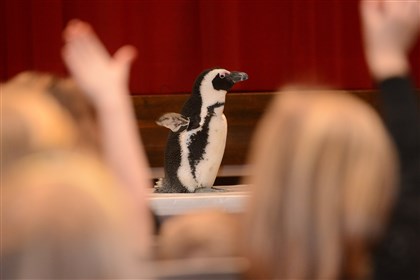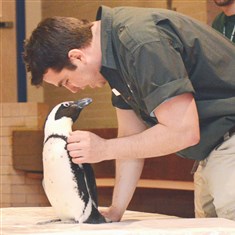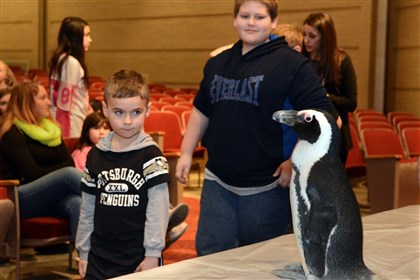The visitor to Ross Elementary School stood stoically at the front of the auditorium — even as students and teachers oohed and aahed, snapped photos and walked past him, examining him closely.
Preston the penguin was quite the hit with the kindergartners and sixth-graders who raised money to “adopt” him at the National Aviary on the North Side.
A kindergarten class and the students' sixth-grade “reading buddies” raised the money after learning that some species of penguins are endangered and after reading a story about a class that had raised money to adopt a penguin. The two classes raised $300 to adopt a penguin.
Through the National Aviary’s Adopt-A-Bird program, that level gives the donor a “personal encounter with your bird,” according to the aviary’s website. On Monday, National Aviary educator Jamie Travitz and intern Brian Stucky loaded Preston — a 6-year-old African penguin — into a carrier and brought him to the school in the North Hills School District. Preston stood on a plastic-covered table in the front of the auditorium, while the students learned all about penguins from Mr. Travitz.
Only the two classes involved in adopting Preston were allowed into the assembly. “We didn’t make it like a big thing, but the kids have been telling everybody,” said kindergarten teacher Lauren Scorzafave. That led many in the school to believe that a Pittsburgh Penguin hockey player would be visiting the school, she added.
The first thing Mr. Travitz told the students is that they needed to stay seated so as not to make Preston nervous. “If he gets nervous, he’s going to want to go back in” the carrier, Mr. Travitz said, and he would not be able to get Preston back out.
The students showed off their knowledge of what makes birds different from other animals, including having beaks and feathers. During a question-and-answer session, Mr. Travitz imparted several facts about penguins in general and about African penguins in particular:
• There are 18 kinds of penguins in the world, and only four types live where it is cold year-round. A couple of weeks ago, he said, the aviary moved most of its penguins indoors because it was too cold for them.
• South African penguins live in a climate that is warmer than Pittsburgh most of the year.
• The aviary puts name tags on the left wing of female penguins and on the right wing of males.
• A penguin’s feathers and blubber keep it warm while it catches fish in water that can be 30 to 40 degrees. Its webbed feet are used for steering, and its paddle-like wings help it move through the water. “He’s built like a little submarine,” Mr. Travitz said of Preston.
• Penguins eat a lot to keep them warm when they molt their feathers. “We’re talking about a beach ball with a penguin head on it,” he said. Preston figured out that the aviary staff would keep giving him food during molting season, and he ate so much that he had to be put on a diet. “Preston more or less figured out how to trick the trainers at the National Aviary,” Mr. Travitz said.
About half of the students raised their hands when they were asked how many had been to the aviary. On future visits, they will be able to find Preston, Mr. Travitz told them.
Preston, he said, is the only penguin with spots on his white belly in sort of a “Mr. America sash” pattern. The students said they enjoyed their encounter with the penguin. “I felt excited,” is how kindergartner Sophia Regan put it. “I like boy penguins,” added her friend, Marley Grenek.
source





















No comments:
Post a Comment